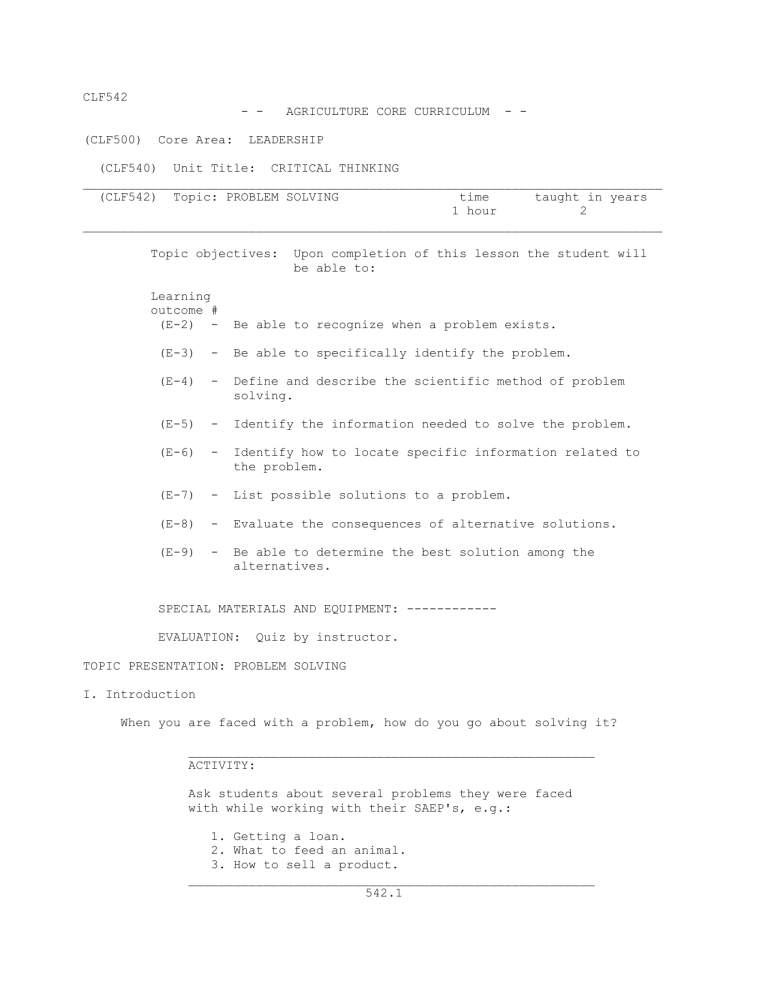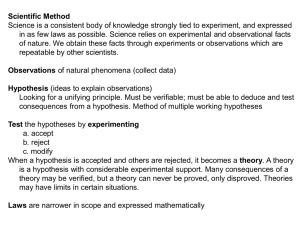CLF542

CLF542
- - AGRICULTURE CORE CURRICULUM - -
(CLF500) Core Area: LEADERSHIP
(CLF540) Unit Title: CRITICAL THINKING
_____________________________________________________________________________
(CLF542) Topic: PROBLEM SOLVING time taught in years
1 hour 2
_____________________________________________________________________________
Topic objectives: Upon completion of this lesson the student will
be able to:
Learning
outcome #
(E-2) - Be able to recognize when a problem exists.
(E-3) - Be able to specifically identify the problem.
(E-4) - Define and describe the scientific method of problem
solving.
(E-5) - Identify the information needed to solve the problem.
(E-6) - Identify how to locate specific information related to
the problem.
(E-7) - List possible solutions to a problem.
(E-8) - Evaluate the consequences of alternative solutions.
(E-9) - Be able to determine the best solution among the
alternatives.
SPECIAL MATERIALS AND EQUIPMENT: ------------
EVALUATION: Quiz by instructor.
TOPIC PRESENTATION: PROBLEM SOLVING
I. Introduction
When you are faced with a problem, how do you go about solving it?
______________________________________________________
ACTIVITY:
Ask students about several problems they were faced
with while working with their SAEP's, e.g.:
1. Getting a loan.
2. What to feed an animal.
3. How to sell a product.
______________________________________________________
542.1
A. Identifying the problem
1. It is possible to have more than one problem.
2. Try to define the problem down to its simplest form.
3. Must have an open mind so as to recognize that the problem
exists.
B. Form a hypothesis
1. A hypothesis is a possible solution to a problem.
2. Brainstorm to formulate any and all possible hypotheses.
a. no idea is impossible.
b. list any ideas that come up.
3. Narrow down your list to the more relevant hypothesis.
______________________________________________________
ACTIVITY:
Give problem situations and have students:
1. State what the problem is;
2. Identify the information and resources needed to
solve the problem.
3. Develop possible solutions to the problem.
______________________________________________________
C. Test your hypothesis
1. Give your hypothesis a try in the "real world".
2. You may want to test several hypotheses at once.
D. Collecting your data
1. Be sure to keep all records of results in written form.
2. Record data in such a way that it is easy to compare results.
E. Form conclusions
1. Choose the hypothesis that best fits the given situation.
2. If none of the hypotheses fit the problem go back to step
one and begin the problem solving process again.
______________________________________________________
ACTIVITY:
Involve students with hypothetical problems
pertaining to various SAE's, (e.g., what to do with
a sick animal, feed formulation) by forming problem
solving groups and having each group present a report.
______________________________________________________
542.2
II. Summary
Problem: What is the best way to castrate Mr. Jones' buck lambs?
A. Hypotheses:
1. burdizzo
2. elastrator
3. knife and teeth
B. Testing hypotheses
1. Collect data on all three methods
2. Where can you get information?
a. extension services
b. other ranchers
c. local veterinarian
d. other
C. Collect and compare your data
1. Write down your results in chart form
2. Remember - ease of comparison is important
D. Form conclusions
1. Choose hypothesis which best fits the problem
2. Factors to keep in mind:
a. time
b. money
c. ease of application
d. grossout quotient
______________________________________________________
ACTIVITY:
Among a set of possible solutions to a stated
problem, have the students identify the best solution
and defend their choice.
______________________________________________________
542.3



